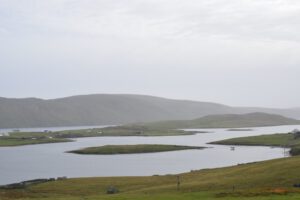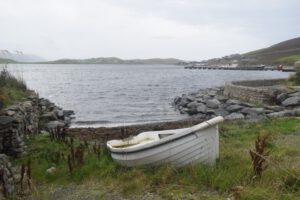By Jacoby Elrod, class of 2021
As a Heritage Studies student I had the opportunity to work with PhD candidate Marilena Mela on a project examining the nexus of heritage and energy transitions in the Shetland Islands. This project was particularly exciting to me as I am interested in coastal landscapes and the unique heritage management opportunities and challenges facing these places. Going into the project my understanding of the Shetland landscape and the heritage of these remote islands off Scotland’s mainland was superficial at best. But through interviews with stakeholders in Shetland along with a review of historical and contemporary energy production projects I was able to gain a deeper appreciation for the unique heritage of the islands, the energy sector’s relationship with the community, and how current transitions to renewable energy are relating to the landscape and challenging entrenched understandings of the commons.

Having established some early understandings of energy transitions and heritage management through interview transcriptions and by familiarizing myself with Marilena’s previous case studies on archipelagos in Greece and the Netherlands, I began work on a literature review of two types of energy production that are part of the ongoing renewable efforts on Shetland – wind and tidal. From the literature I learned about efforts to make Shetland a world leader in the production of renewable energy and was introduced to details of existing and planned wind and tidal energy projects. This review also introduced me to arguments for and against the implementation of such energy production methods and the supporting infrastructure that on shore developments often require. Such projects can have implications for the commons and community perceptions over ownership of the landscape. There are challenges of balancing the protection of the commons and the desires of local communities with the needs of society at large, particularly when it comes to the need to produce significantly more amounts of renewable energy to meet the demands of today’s climate crisis.

Though this case focused on Shetland, there are broader takeaways for the heritage professional. Through this case I have learned to see islands, in the way of Baldacchino, as a combination of open and enclosed areas, and to analyze how these characteristics of islandness influence residents’ perceptions of landscape. I have been interested to see how, while non-islanders may see the waters surrounding islands as boundaries – as confining elements – for many island communities these bodies of water are connective elements. Seas have historically served as conduits for trade and exploration, and for many islanders they provided a living from fishing. To some extent the lessons I have learned in the study of the Shetland case and in the case of other island communities might be applied to the study of mainland rural areas as well, where a feeling of remoteness and possible disconnect from more populated areas can have impacts on the study of heritage, spatial planning, sustainable energy development, and the perceived value of landscapes.
This case study has provided me with knowledge that will improve my ability to be an effective heritage professional. The internship offered the opportunity to explore the heritage of an island landscape and to engage with contemporary issues that are challenging community perceptions of place. I have gained skills in reading the biography of a landscape and have learned what questions a heritage professional can ask when considering spatial planning initiatives. The case stresses the importance of understanding nuances in landscape perception, the importance of structuring projects in ways that not only get community support but support the community, and reiterates the importance of community inclusion in the spatial planning process. I have seen that heritage production is a selective process, where communities rely upon particular elements in their history when it comes to creating heritage. Simultaneously excluding other historical elements that might not align with their narrative. Ultimately, I have learned that heritage professionals have a role to play in stewarding the interdisciplinary discussions that must be had in communities under pressure from climate change, development, and energy transitions. In coordination with other professionals and with the involvement of the public, creative plans can be developed that weigh the needs of communities with the desires to protect and promote cultural heritage, ecological function, economic viability, and social inclusion.